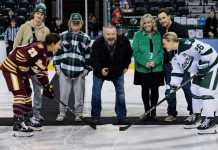Which Wolverines Came to Albany?
Michigan coach Red Berenson, regardless of the tradition associated with his hockey program, was the first to admit that his team is very different from the other three in the tournament field.
“I’m never quite sure which team will show up,” said Berenson. “I think our team finally realized that they need to do to play well. But in our last 10 games, I think we’re barely .500.
I can’t tell you from game to game with this team what kind of game we’re going to get. We’re feeling pretty ourselves, but if we feel too good about ourselves, then it will be a short weekend.”
Fond Memories
As the coaches sat around the table at Wednesday’s press conference, plenty of smiles and laughs were shared when each was asked to share experiences.
Berenson remembered back to 1962 when his Michigan team played in the NCAA tournament in Utica, N.Y., and the fact that though his team traveled there by train, Berenson himself never made it back.
“The day after the tournament, I turned professional and I signed with Montreal,” Berenson reminisced. “Montreal was actually at the tournament and drove me to Boston where I signed a pro contract that night.
“That was a great thrill for me, because they used to tell the players back then that if you go to college, then you’ll never be a pro.”
Michigan State coach Ron Mason immediately asked Berenson what his signing bonus was. Red’s response?
“I told them I wanted $20,000 over two years, any way they wanted to pay me. And they said, ‘That’s ridiculous. We’ve never paid anybody that much.
“I told them that’s what I wanted and then they gave it to me. I thought, ‘I’ve pulled a good one here.'”
BC’s Jerry York couldn’t help joking in return.
“Did you have to split much of that with your agent,” York said to a room full of laughing media .
Enjoying the Growth
Reminiscing certainly didn’t end with Berenson. All four coaches talked about their own tournament experience, but more importantly, where the tournament has come since its inception in 1948.
York talked about 1965’s tournament, held at Brown University.
“The seating capacity [at Brown] was under 3,000, and we were all so excited that [the tournament] was sold out,” said York. “Now they say 15,000 is the [minimum] seating capacity, so that tells us all a lot about where the tournament has gone.
“We’re lucky to have ESPN televise all of these [Frozen Four] games. It would be nice to have them pick up a game of the month next year.”
North Dakota’s Dean Blais likened his experience to that of basketball.
“We’d like to have the same exposure as the tournament does in basketball. I think it’s getting there. But the coaching body, in general is patient with the coverage. It was good last year in Providence [where North Dakota won the national championship] and it’s good this year in Albany.”
Mason talked of his days playing at St. Lawrence, noting back then, the new experiences that players found were a lot different from today.
“I got on an airplane here in Albany to fly to Denver in 1961 and we were flying on a prop plane,” said Mason. “It was the first time I’d ever flown, so that’s how far back I go.”
Attracting a (Small) Crowd
The practice sessions at the Frozen Four are nowhere near as glamorous as the ones enjoyed by the men’s basketball Final Four.
In basketball, thousands of fans pack the arena for a look at the teams. Bands are invited to play. It’s almost like a game atmosphere.
In hockey, though, it’s just a practice. Plain and simple.
Boston College took the ice for its 60-minute session just before 2:30 p.m. Wednesday, and roughly 50 people were in the 17,500-seat arena. That’s a generous figure considering a number of them were staff members doing final preparations.
No band, no frills; just the ice time.
Well, a band was there. Part of one, at least.
A handful of members of the North Dakota band sat at the end of the lower level and watched BC practice.
“We were walking through the downtown and we thought we’d stop in and check them out, see what they’re looking like today,” said Tammy Mulske, an alto sax player decked out in a black Sioux jersey.
Some scouting, maybe?
“No, just for ourselves,” she said.
Berenson said he’s always a bit leery about the practice the day before a Frozen Four game.
“We’ve been in this event a number of times and I can’t remember us having a good practice the day before the game,” Berenson said. “It scares you because you don’t know what you’re going to get the next day, whether they’re nervous or too relaxed.
“I think there will be a lot of nerves out there, especially early in the games. Hopefully it doesn’t cost anybody.”
The Usual Questions
It’s a question Boston College coach Jerry York said he gets a lot.
Three straight years at the Frozen Four and he’s 0-for-3 in that time in getting a national championship. Is there any more pressure the fourth time to win the school’s first NCAA hockey title since 1949?
“I guess the alternative is to stay home and not get here,” York quipped.
Repeat Redux
Blais has a vivid memory of the last time a team repeated as NCAA hockey champion. He was on the short end of one of Boston University’s back-to-back titles in 1971 and 1972.
Blais was an all-tournament selection in 1971, when his Minnesota team lost to BU in the championship game.
A team looking for back-to-back titles has become a theme at the Frozen Four. North Dakota knocked off then-defending champ Maine last season, and Michigan State has the chance to unseat the title-holder this year.
Room to Roam
An odd quirk about Albany’s Pepsi Arena, site of the Frozen Four, is the depth of the player benches and penalty boxes.
At most arenas, those areas go roughly 6 to 8 feet deep. In Albany, though, the space is noticeably larger, probably 10 to 12 feet. It’s another approximately 6 feet from the back of the bench to the start of the seats, elevated above the players.
What exactly, you may be asking, are the coaches planning to do with that space?
Well, spread out a little.
“Too often the hockey benches are too darn small,” Mason said. “This is perfect.”
Mason also noted the area behind the bench is elevated, so the coaches have an easier time seeing past standing players.
“The benches that are tough are the ones in which you’re down at the same level as the players,” he said.
Rate the Ice
The Pepsi Arena ice surface, only a few days old and therefore brimming with fresh lines and crisp logos, didn’t seem like new ice, the coaches said.
Any wear and tear noticeable at the end of Wednesday’s practice session can be chalked up to plenty of use in a short time, Mason said.
“When you get four teams skating back to back like that, obviously the third and fourth teams are probably going to experience tougher ice,” he said. “It didn’t seem like brand new ice.”
About That Band
The UND band came to Albany on the school’s charter, but they had to do some legwork to pull it off.
Mulske said the band needed to raise $16,500 to send the group to the Frozen Four. Through radio donations, the group raised $18,000.
But, no, there will be no $1,500 party on the Sioux band. It still has to pay off trips to the WCHA Final Five and NCAA East Regional and buy some new uniforms.



